Investigation on Response of Site of Typical Soil–Rock Composite Strata in Changchun Induced by Shield Construction of Parallel Twin Tunnels
Abstract
1. Introduction
2. Project Overview
2.1. Engineering Geological Conditions
2.2. Parameters of Tunneling
3. Research Methods
4. Deformation Characteristics of Site
4.1. Ground Settlements along the Direction of Tunneling
4.2. Ground Settlement Trough
4.3. Effect of the Shield Tunneling of the Left Tube on the Right One
5. Analysis of Numerical Results
6. Conclusions
Author Contributions
Funding
Institutional Review Board Statement
Informed Consent Statement
Data Availability Statement
Conflicts of Interest
References
- Peck, R. Deep excavations and tunneling in soft ground. In Proceedings of the 7th International Conference on Soil Mechanics and Foundation Engineering (SMFE ’69), Mexico City, Mexico; 1969; pp. 225–290. [Google Scholar]
- Attewell, P.B.; Woodman, J.P. Predicting the dynamics of ground settlement and its derivatives caused by tunneling in soil. Ground Eng. 1982, 15, 13–22. [Google Scholar] [CrossRef]
- Attewell, P.B.; Yeates, J.; Selby, A.R. Soil Movements Induced by Tunneling and Their Effects on Pipelines and Structures; Blackie & Son Ltd.: Glasgow, Scotland, 1986; Volume 352, pp. 10–50. [Google Scholar]
- New, B.; O’Reilly, M. Tunneling induced ground movements, predicting their magnitude and effects. In Proceedings of the 4th International Conference on Ground Movement and Strucutures, Cardiff, UK, 8–11 July 1991; pp. 671–697. [Google Scholar]
- Jiang, X.; Zhao, Z.; Li, Y. Analysis and calculation of surface and subsurface settlement trough profiles due to tunneling. Rock Soil Mech. 2004, 25, 1542–1544. (In Chinese) [Google Scholar]
- Han, X.; Li, N.; Standing, J. An adaptability study of Gaussian equation applied to predicting ground settlements induced by tunneling in China. Rock Soil Mech. 2007, 28, 23–28. (In Chinese) [Google Scholar]
- Wei, G. Study on calculation for width parameter of surface settlement trough induced by shield tunnel. Ind. Constr. 2009, 39, 74–79. (In Chinese) [Google Scholar]
- Wei, G. Selection and distribution of ground loss ratio induced by shield tunnel construction. Chin. J. Geotech. Eng. 2010, 32, 1354–1361. (In Chinese) [Google Scholar]
- Yao, A.; Zhao, Q.; Guan, J.; Liu, F.Y.; Su, N. Improvement of Peck Formula in subway construction in Beijing. Chin. J. Undergr. Space Eng. 2010, 6, 789–793. (In Chinese) [Google Scholar]
- Yang, Q.; Ma, F.; Hu, G.; Guo, X. Improvement of Peck formula in subway construction under typical geological conditions. J. Liaoning Tech. Univ. (Nat. Sci.) 2012, 31, 159–162. (In Chinese) [Google Scholar]
- Chen, C.; Zhao, C.; Wei, G.; Ding, Z. Prediction of soil settlement induced by double-line shield tunnel based on Peck formula. Rock Soil Mech. 2014, 35, 2212–2218. (In Chinese) [Google Scholar]
- Zheng, X.; Ma, F. Improvement of Peck Formula in Subway Construction in Changchun. Chin. J. Undergr. Space Eng. 2017, 13, 732–736. (In Chinese) [Google Scholar]
- Zhou, J.; Shi, X.; Du, K. Feasibility of Random-Forest Approach for Prediction of Ground Settlements Induced by the Construction of a Shield-Driven Tunnel. Int. J. Geomech. 2017, 17, 04016129. [Google Scholar] [CrossRef]
- Verruijt, A.; Booker, J.R. Surface settlements due to deformation of a tunnel in an elastic half plane. Geotechnique 1996, 46, 753–756. [Google Scholar] [CrossRef]
- Melis, M.; Medina, L.; Rodriguez, J.M. Prediction and analysis of subsidence induced by shield tunneling in the Madrid Metro extension. Can. Geotech. J. 2002, 39, 1273–1287. [Google Scholar] [CrossRef]
- Melis, M.; Rodríguez, L. Predicted versus measured soil movements induced by shield tunneling in the Madrid Metro extension. Can. Geotech. J. 2005, 42, 1160–1172. [Google Scholar] [CrossRef]
- Lambrughi, A.; Rodríguez, L.; Castellanza, R. Development and validation of a 3D numerical model for TBM–EPB mechanised excavations. Comput. Geotech. 2012, 40, 97–113. [Google Scholar] [CrossRef]
- Fu, J.Y.; Yang, J.S.; Klapperich, H. Analytical Prediction of Ground Movements due to a Nonuniform Deforming Tunnel. Int. J. Geomech. 2016, 16, 04015089. [Google Scholar] [CrossRef]
- Jiang, M.; Sima, J.; Cui, Y.; Hu, H.; Zhou, C.; Lei, H. Experimental Investigation of the Deformation Characteristics of Natural Loess under the Stress Paths in Shield Tunnel Excavation. Int. J. Geomech. 2017, 17, 04017079. [Google Scholar] [CrossRef]
- Ma, G.; Zheng, H.; Li, P. Displacement characteristics for a “π” shaped double cross-duct excavated by cross diaphragm (CRD) method. Tunn. Undergr. Space Technol. 2018, 77, 204–215. [Google Scholar] [CrossRef]
- Zhou, J.; Chen, D.; Wang, D. Failure Probability of Transverse Surface Settlement Induced by EPB Shield Tunneling in Clayey Soils. ASCE ASME J. Risk Uncertain. Eng. Syst. Part A Civ. Eng. 2018, 4, 04018030. [Google Scholar] [CrossRef]
- Qiu, J.; Shen, Y.; Zhang, X.; Zhang, Y.; Gan, Y.; Zhou, X. Simplified method for predicting time-dependent behavior of deep-buried tunnel considering tunnel excavation rate and stress release effects. Int. J. Appl. Mech. 2022, 14, 2250043. [Google Scholar] [CrossRef]
- Tao, Y.; He, W.; Sun, H.; Cai, Y.; Chen, J. Multi-objective optimization-based prediction of excavation-induced tunnel displacement. Undergr. Space 2022, 7, 735–747. [Google Scholar] [CrossRef]
- Deng, S.; He, Y.; Gong, X.; Zhou, J.; Hu, X. A Hybrid Regional Model for Predicting Ground Deformation Induced by Large-Section Tunnel Excavation. Comput. Model. Eng. Sci. 2023, 134, 495–516. [Google Scholar] [CrossRef]
- Palmstrom, A.; Stille, H. Ground behavior and Rock Engineering Tools for Underground Excavations. Tunn. Undergr. Space Technol. 2007, 22, 363–376. [Google Scholar] [CrossRef]
- Li, L.; Du, X.; Zhou, J. Numerical Simulation of Site Deformation Induced by Shield Tunneling in Typical Upper-Soft-Lower-Hard Soil-Rock Composite Stratum Site of Changchun. KSCE J. Civ. Eng. 2020, 24, 3156–3168. [Google Scholar] [CrossRef]
- GB/T 50218; Standard for Engineering Classification of Rock Mass. China Planning Press: Beijing, China, 2014. (In Chinese)
- GB 50307; Code for Geotechnical Investigations of Urban Rail Transit. China Planning Press: Beijing, China, 2012. (In Chinese)
- GB 50164; Standard for Quality Control of Concrete. China Architecture & Building Press: Beijing, China, 2011. (In Chinese)
- Han, L.; Wei, H.; Zhang, Y.; Zhang, J.; Wang, F. Study on Cold Resistance Performance of Composite Subgrade Structure in Seasonal Frozen Regions. Appl. Sci. 2020, 10, 4681. [Google Scholar] [CrossRef]
- Meng, F.-Y.; Chen, R.-P.; Xu, Y.; Wu, K.; Wu, H.-N.; Liu, Y. Contributions to responses of existing tunnel subjected to nearby excavation: A review. Tunn. Undergr. Space Technol. 2022, 119, 104195. [Google Scholar] [CrossRef]

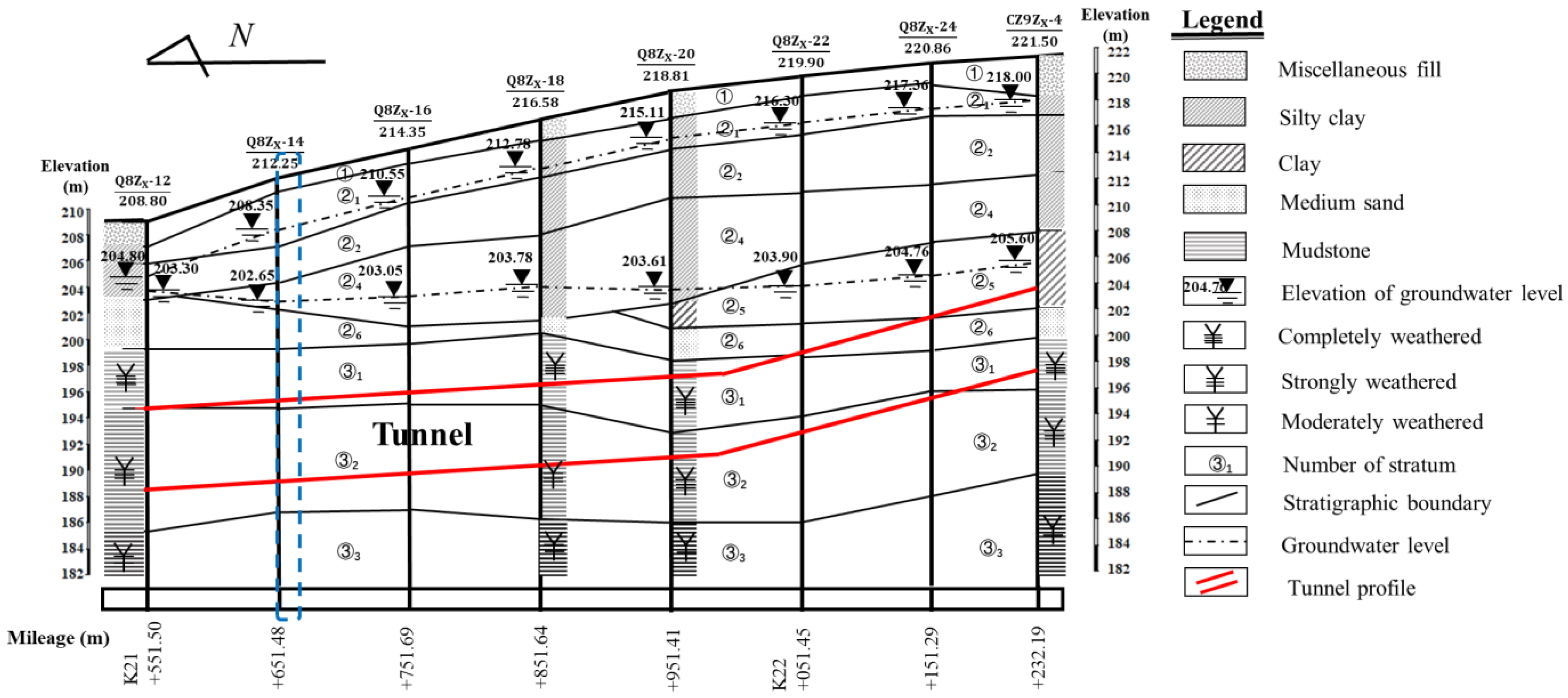
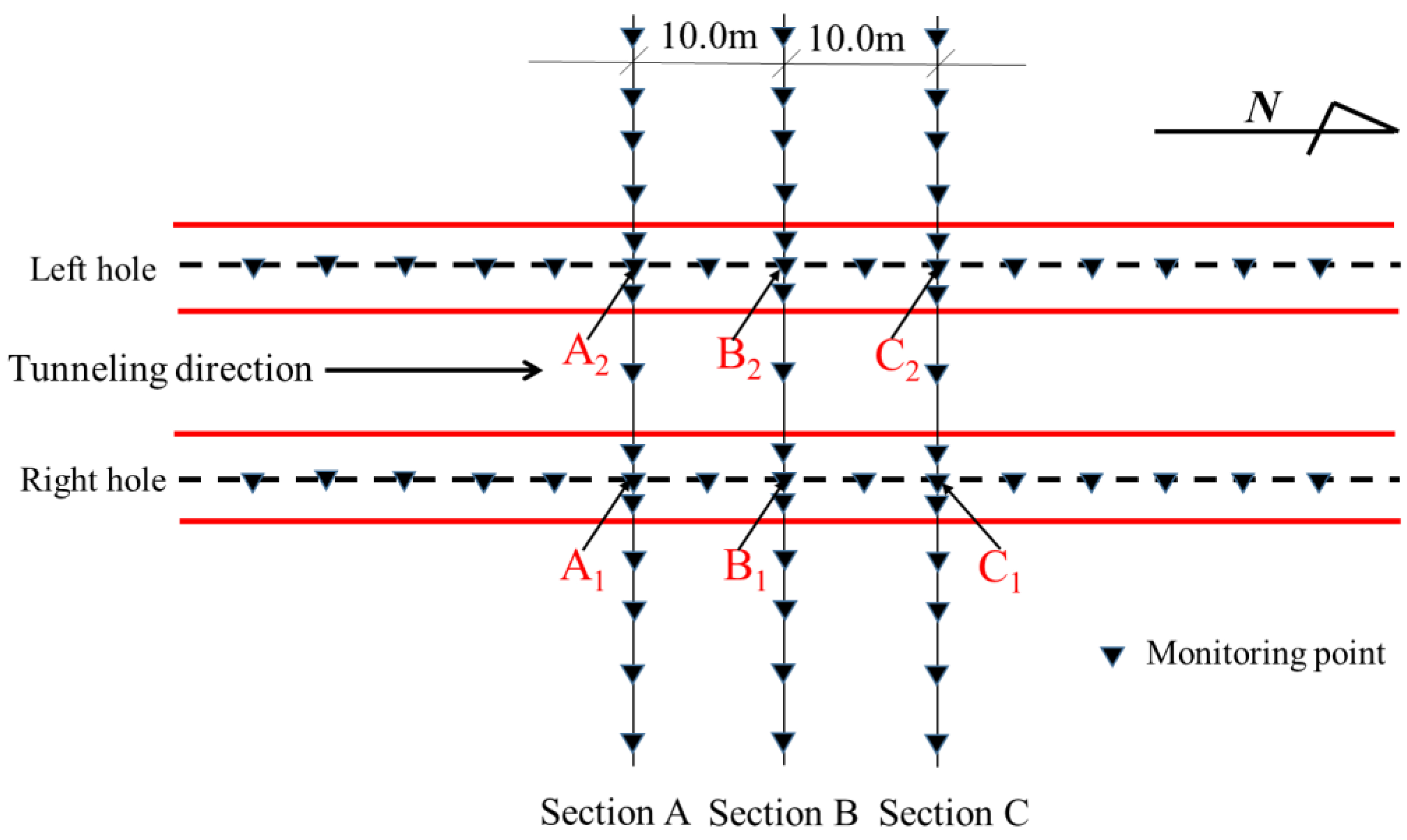
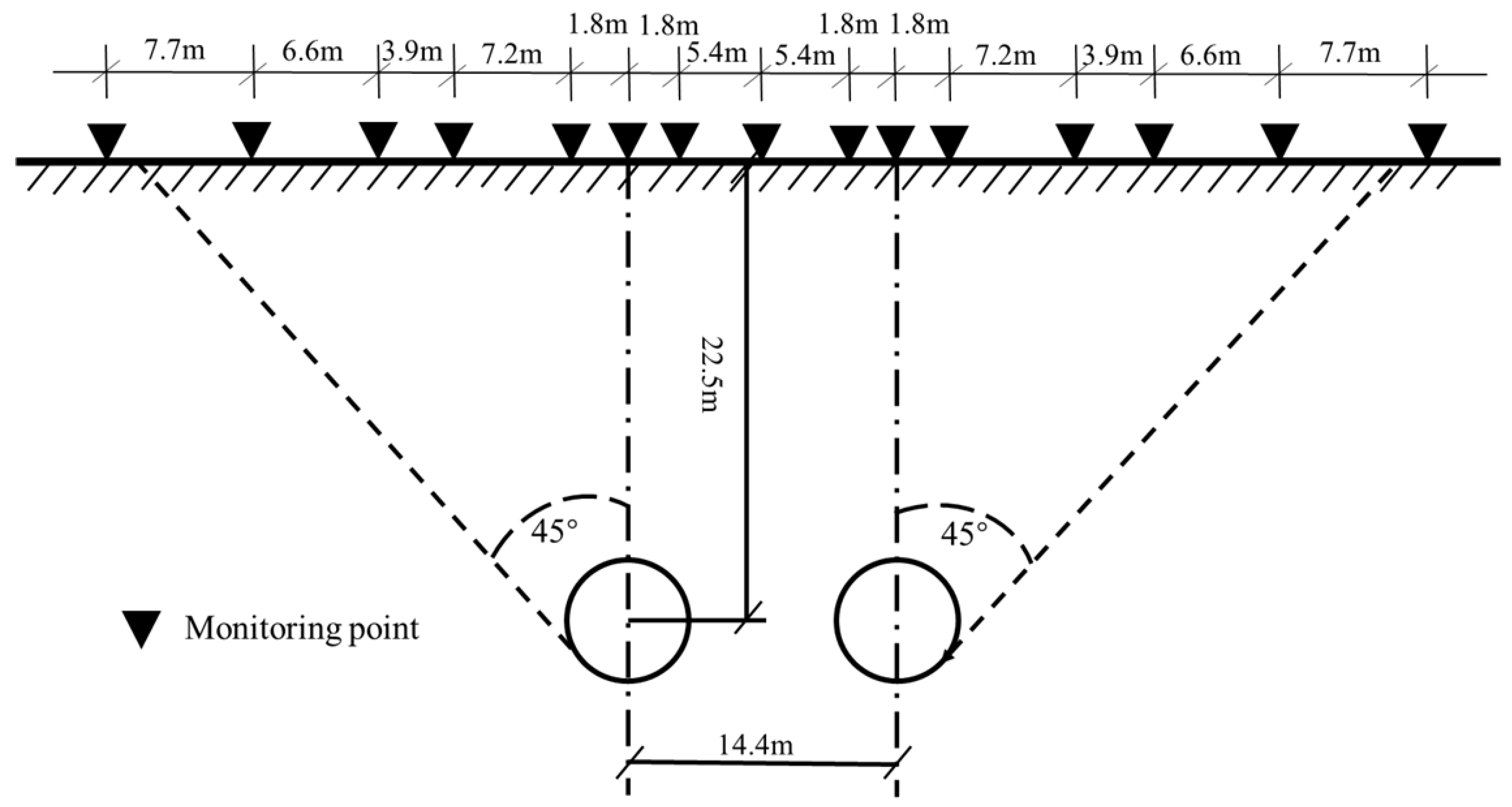

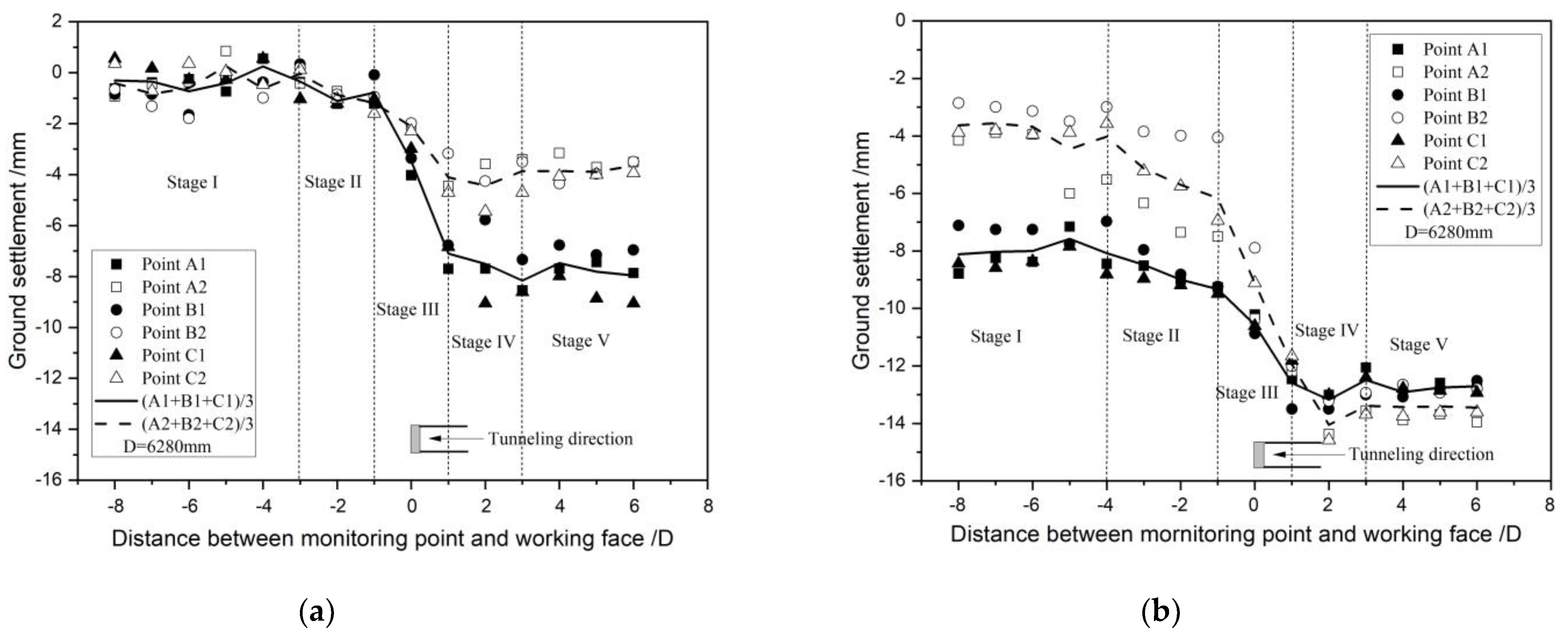
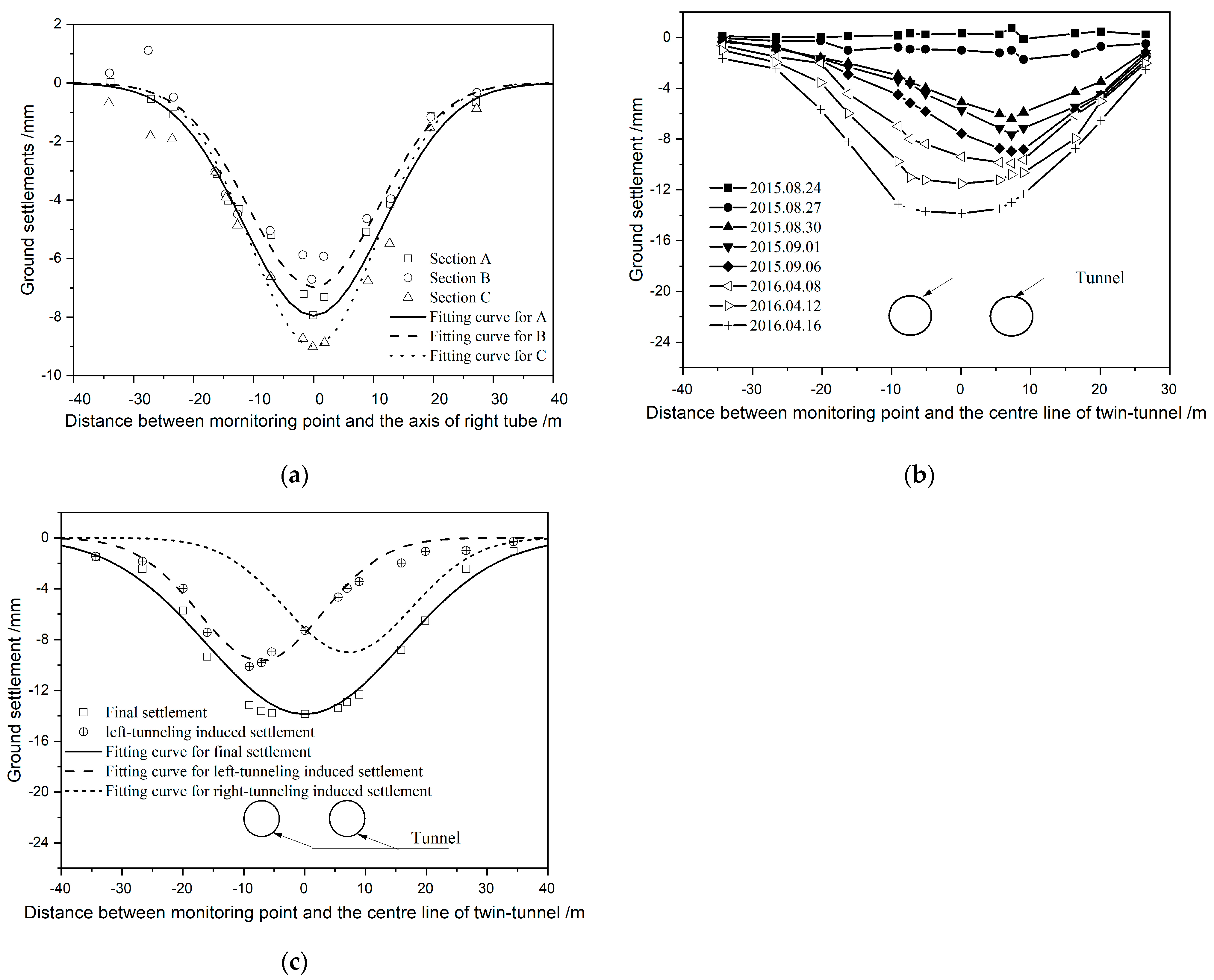
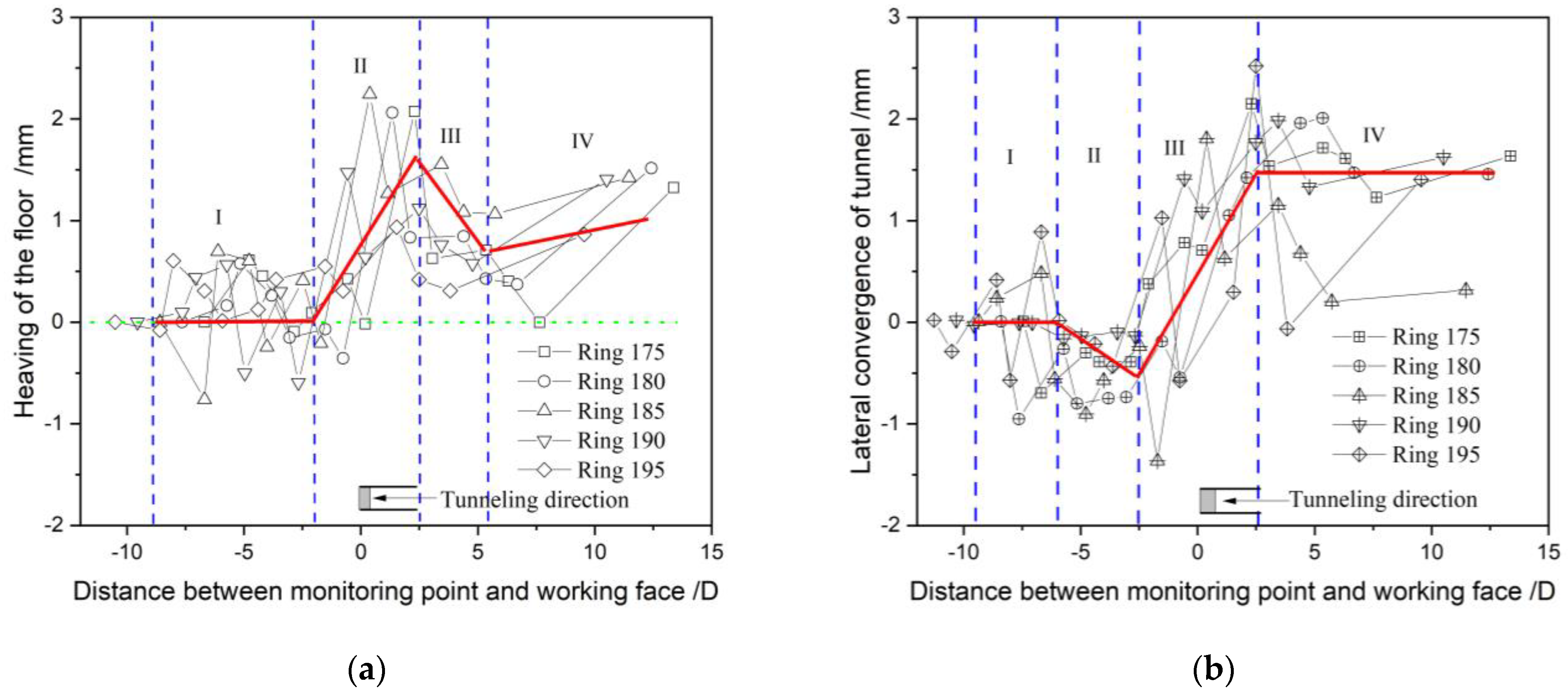
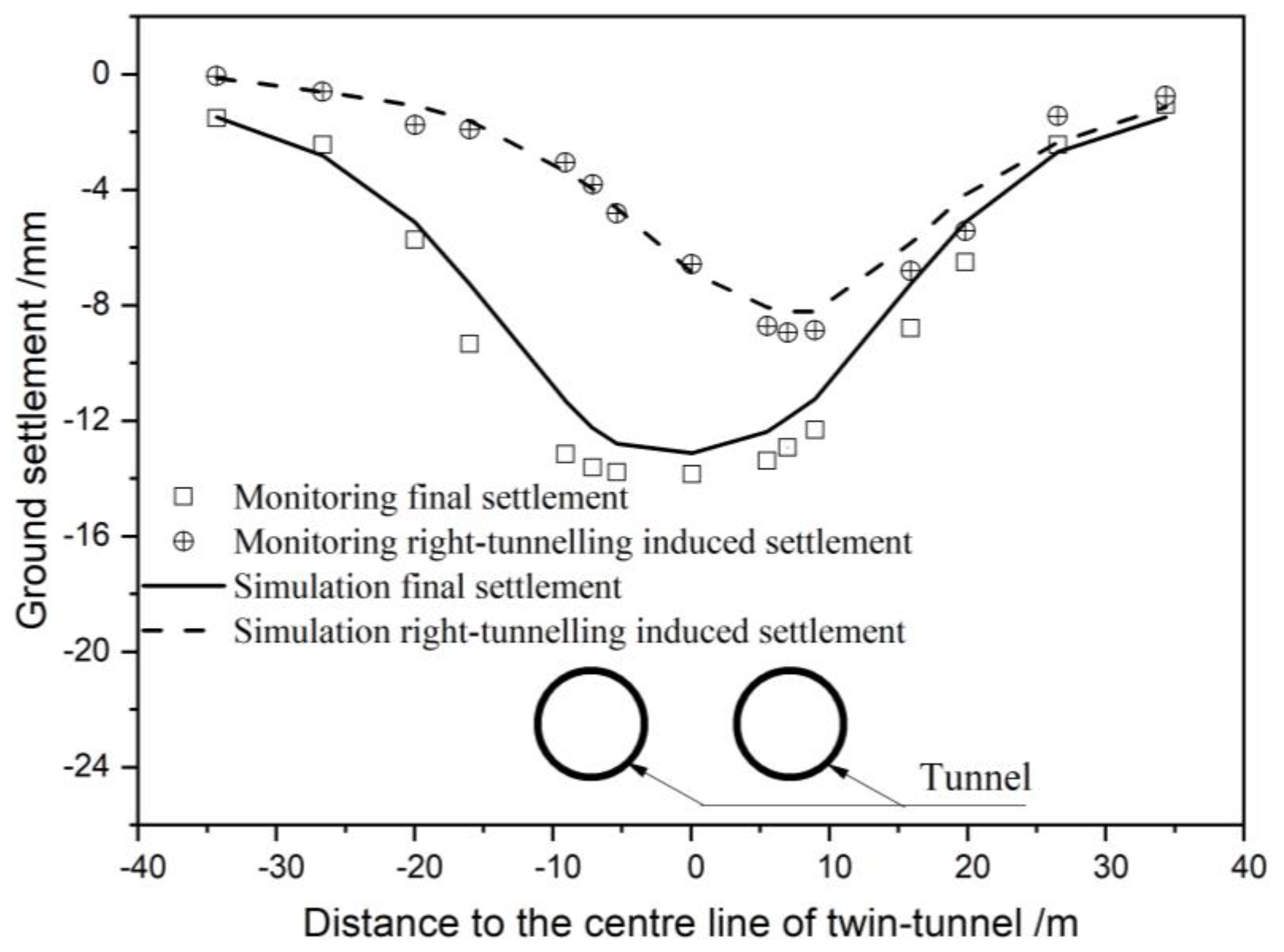

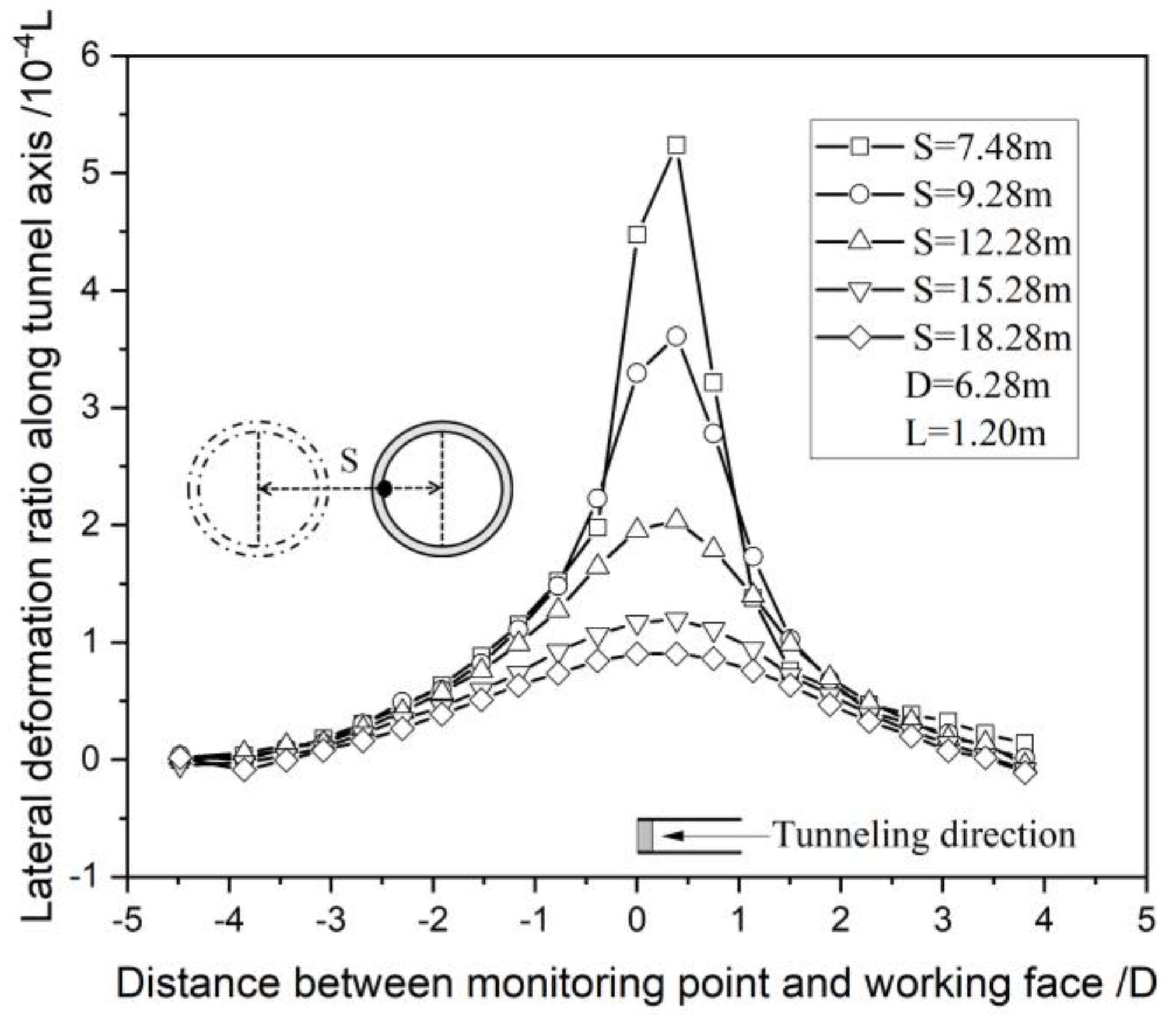
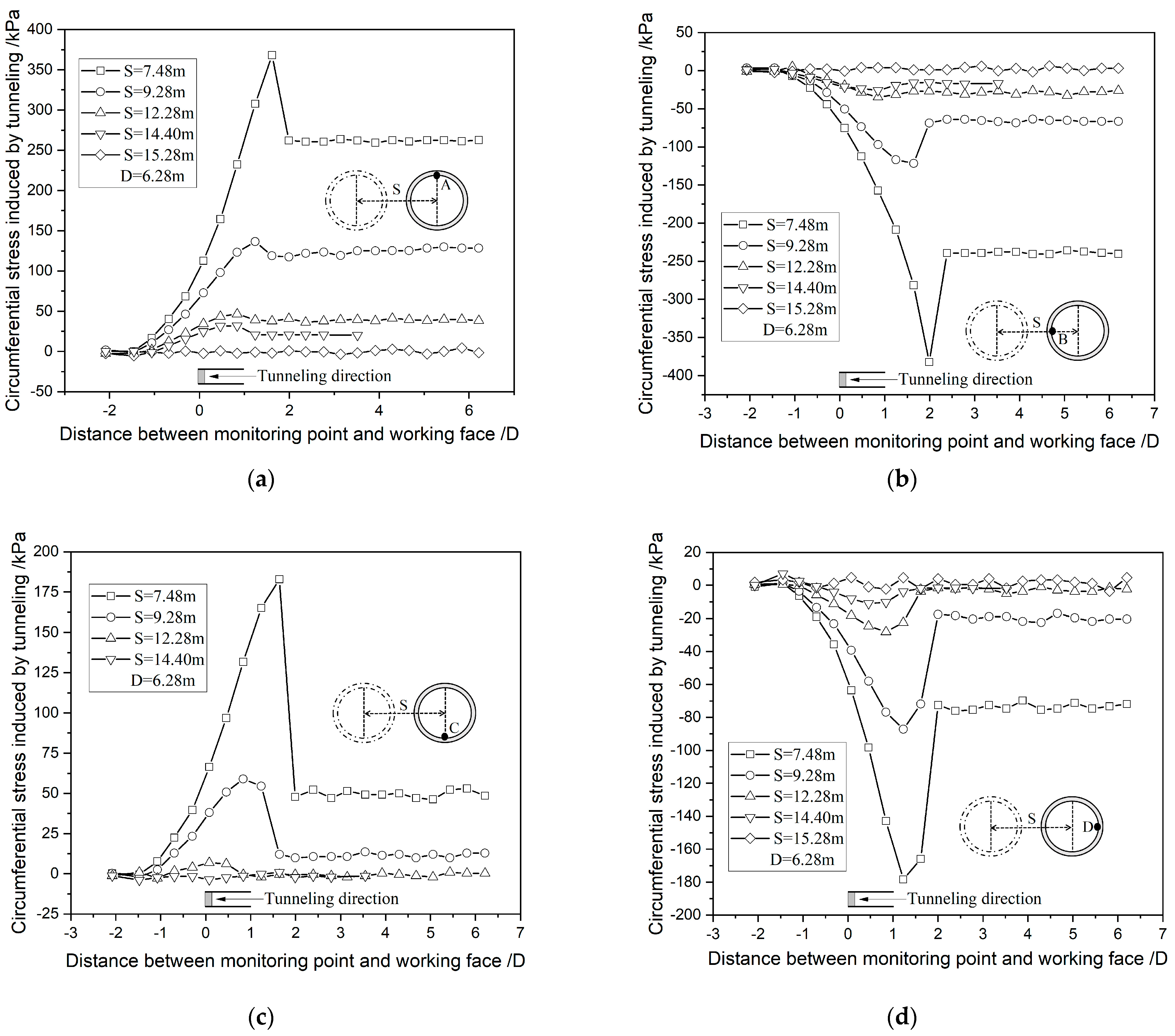
| Stratigraphic Number | Geological Age | Lithology | Status | Thickness/m | Average Thickness/m | Steady Ability * | Grade of Surrounding Strata * | Distribution |
|---|---|---|---|---|---|---|---|---|
| ① | artificial fill | slightly wet and slightly dense | 0.70–4.30 | 1.89 | Easy to collapse | VI | Whole | |
| ②1 | Middle Pleistocene of Quaternary | silty clay | plastic to hard plastic | 0.90–4.30 | 2.41 | Bad | VI | Missing in some sections |
| ②2 | silty clay | plastic or local soft plastic | 1.60–7.50 | 3.88 | Bad | VI | Whole | |
| ②3 | silty clay | plastic to hard plastic | 1.90–8.00 | 4.93 | Ordinary | VI | Found only in the south section | |
| ②4 | clay | plastic to hard plastic | 1.90–7.30 | 5.30 | Ordinary | VI | Found only in the south section | |
| ②5 | medium sand | medium-density to dense | 0.90–3.80 | 2.04 | Poor | VI | Found only in the south section | |
| ③1 | Cretaceous | completely weathered mudstone | layering structure and original rock structure was destroyed | 3.10–9.60 | 5.82 | Poor | VI | Whole |
| ③2 | strongly weathered mudstone | layering structure with developed joints and fissures | 5.60–15.00 | 8.50 | Ordinary | V | Whole | |
| ③3 | moderately weathered mudstone | layering structure with well-developed joints and fissures | 7.00–39.00 | - | Ordinary | V | Whole |
| Items | Outer Diameter of Hole/mm | Inner Diameter of Hole/mm | Number of Segments per Ring | Segment Width/mm | Segment Thickness/mm | Design Strength Grade of Segment Concrete * | Impermeability Grade * |
|---|---|---|---|---|---|---|---|
| Value | 6000.0 | 5400.0 | 6 | 1200.0 | 300.0 | C50 | P10 |
| Items | Length of Shield Body/m | Cutter Head Diameter/mm | External Diameter of Shield Shell/mm | Length of Shield Shell/mm |
|---|---|---|---|---|
| Value | 9.0 | 6280.0 | 6250.0 | 6000.0 |
| Items | Thickness of shield shell/mm | Maximum driving speed/(mm/min) | Maximum thrust/ton | Maximum working pressure/bar |
| Value | 40.0 | 100.0 | 3600.0 | 5.0 |
| Items | Maximum design pressure/bar | Cutterhead opening ratio | Excavation diameter/mm | Overbreak diameter/mm |
| Value | 6.0 | 35% | 6280.0 | 6364.0 |
| Items | Number of overbreak cutters | Number of wear detection knives | Blade spacing between scrapers/mm | Cutter spacing between hobs/mm |
| Value | 2 | 2 | 10.0 | 90.0 |
| Items | Axial turning force of hob/N·m | Number of mud and foam entrance | Rated torque of main drive system/ton·m | Lifting capacity of segment erector/W * |
| Value | 15.0–25.0 | 7 | 685.0 | 1.3 |
| Items | Total thrust of propulsion system/kN | Grease supply pressure of shield tail grease system/bar | Transport capacity of belt conveyor/(ton/h) | Slag output of screw conveyor/(m3/h) |
| Value | 36,000.0 | 2050.0 | 800.0 | 430.0 |
| Items | Grouting capacity/(m3/h) | Pumping capacity of foam system/(L/min) | Mixing capacity of bentonite system/(L/min) | |
| Value | 22.0 | 2000.0 | 500.0 |
| Items | Thrust Force of the Jack/Ton | Driving Pressure/kPa | Grouting Pressure/kPa | Tunneling Velocity/(mm/min) |
|---|---|---|---|---|
| Value | 120.0 | 200.0 | 150.0 | 50.0 |
| Items | Earth chamber pressure/kPa | Slurry type | Synchronous grouting quantity/(m3/m) | |
| Value | 160.0 | Single slurry | 5.0 |
| Name of Strata | Density/(kg/m3) | Shear Modulus/MPa | Bulk Modulus/MPa | Poisson Ratio | Cohesion/kPa | Internal Friction Angle/(°) | Thickness/m |
|---|---|---|---|---|---|---|---|
| Fill ① | 1750 | 5.72 | 13.15 | 0.31 | 18.0 | 10.0 | 1.4 |
| Silty clay ②1 | 1970 | 7.69 | 16.66 | 0.30 | 53.4 | 15.4 | 2.6 |
| Silty clay ②2 | 1970 | 11.11 | 33.33 | 0.35 | 32.9 | 18.6 | 3.0 |
| Clay ②4 | 1990 | 13.67 | 26.51 | 0.28 | 57.4 | 14.4 | 4.3 |
| Medium sand ②6 | 2020 | 12.02 | 20.11 | 0.25 | 1.0 | 35.0 | 2.2 |
| Completely weathered mudstone ③1 | 1940 | 19.35 | 30.76 | 0.24 | 32.1 | 21.1 | 6.0 |
| Strongly weathered mudstone ③2 | 2010 | 24.39 | 37.03 | 0.23 | 60.0 | 20.0 | 6.5 |
| Moderately weathered mudstone ③3 | 2310 | 49.58 | 68.96 | 0.21 | 70.0 | 18.8 | 26.5 |
| Structural Members | Density/(kg/m3) | Elastic Modulus/GPa | Poisson Ratio | Conversion Coefficient | Clearance Value of Shield Tail/m |
|---|---|---|---|---|---|
| Segmental lining | 2500.0 | 35.0 | 0.2 | - | - |
| Shield shell | 2500.0 | 200.0 | 0.2 | - | - |
| Clearance element | 1.0‰Es | - | - | ||
| Equivalent layer | 0.22 | 0.2 | 1.0 | 0.14 |
| Shield Driving | Smax/mm | i/m | Vs/m3 | Vl/% |
|---|---|---|---|---|
| The right tunnel | 6.70–9.01 | 10.48–14.37 | 0.191–0.241 | 0.62–0.76 |
| The left tunnel | 9.68 | 10.21 | 0.248 | 0.80 |
| Double tunnels | 13.87 | 15.94 | 0.555 | 0.89 |
| Cases | With an Adjacent Tunnel | Without Adjacent Tunnel | Influence of Adjacent Tunnel | Relative Position between Two Tunnels | |||||||||
|---|---|---|---|---|---|---|---|---|---|---|---|---|---|
| S/m | YA | XB | YC | XD | YA | XB | YC | XD | YA | XB | YC | XD | |
| 7.48 | −20.9 | −11.1 | 20.4 | 6.4 | −23.9 | −11.2 | 21.5 | 10.1 | −3.0 | −0.1 | −1.1 | −3.7 |  |
| 9.28 | −22.0 | −11.2 | 20.6 | 7.8 | −1.9 | 0 | −0.9 | −2.3 | |||||
| 12.28 | −22.9 | −11.2 | 21.0 | 9.0 | −1.0 | 0 | −0.5 | −1.1 | |||||
| 15.28 | −23.1 | −11.2 | 21.4 | 9.6 | −0.8 | 0 | −0.1 | −0.5 | |||||
| 18.28 | −23.3 | −11.2 | 21.5 | 10.1 | −0.6 | 0 | 0 | 0 | |||||
Disclaimer/Publisher’s Note: The statements, opinions and data contained in all publications are solely those of the individual author(s) and contributor(s) and not of MDPI and/or the editor(s). MDPI and/or the editor(s) disclaim responsibility for any injury to people or property resulting from any ideas, methods, instructions or products referred to in the content. |
© 2024 by the authors. Licensee MDPI, Basel, Switzerland. This article is an open access article distributed under the terms and conditions of the Creative Commons Attribution (CC BY) license (https://creativecommons.org/licenses/by/4.0/).
Share and Cite
Li, L.; Yao, A. Investigation on Response of Site of Typical Soil–Rock Composite Strata in Changchun Induced by Shield Construction of Parallel Twin Tunnels. Appl. Sci. 2024, 14, 500. https://doi.org/10.3390/app14020500
Li L, Yao A. Investigation on Response of Site of Typical Soil–Rock Composite Strata in Changchun Induced by Shield Construction of Parallel Twin Tunnels. Applied Sciences. 2024; 14(2):500. https://doi.org/10.3390/app14020500
Chicago/Turabian StyleLi, Liyun, and Aijun Yao. 2024. "Investigation on Response of Site of Typical Soil–Rock Composite Strata in Changchun Induced by Shield Construction of Parallel Twin Tunnels" Applied Sciences 14, no. 2: 500. https://doi.org/10.3390/app14020500
APA StyleLi, L., & Yao, A. (2024). Investigation on Response of Site of Typical Soil–Rock Composite Strata in Changchun Induced by Shield Construction of Parallel Twin Tunnels. Applied Sciences, 14(2), 500. https://doi.org/10.3390/app14020500





